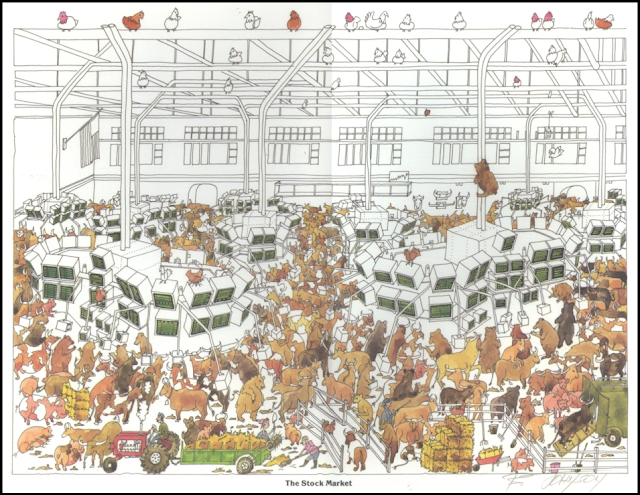
This is more like it. This is almost normal! I'm not saying that means that the market is back to normal; all I'm saying is that it's acting more normal. Time will tell if we've arrived at a bottom. I tend to side with two gents whom I respect very much, John J. Murphy, the chief technical analyst for StockCharts.com, and Dr. Marvin Appel, author of "Investing with Exchange-Traded Funds Made Easy". They think the S&P 500 will retest its low of 750. Here's a 10-year chart of SPX:

Murphy points out that the S&P is now testing the lows of 2002. "There are two ways to view it," he says. "This could be a huge trading range that began eight years ago. If that's the case the market will stabilize in this area." The other view - if the S&P breaks through its 2002 lows, is not so rosy: "[T]he entire eight-year pattern is nothing more than a huge double-top pattern -- which is very negative. We're kind of hoping that doesn't happen."
"Kind of hoping" -- I wonder if he's also playing the short side! :)
Appel thinks the retest will come in 2009 when other sectors are influenced by the current credit crisis. But back to the sector at hand.

The first thing I notice about the Biomedics/Genetics BPI chart is that the last time there were this many column changes was back in 2002. The purple boxes to the right also show us that the majority of the moves this year occurred from September onward. We've got two successive double tops (Oct-Nov and Nov-Dec). These point and figure buy signals are significant on a P&F chart for a specific securtiy, but on a BPI chart they don't mean so much. What's more important is the level (it's at 30%) and whether it's in a column of X's or O's (because of the 6% reversal rule).
We know from our ETFMT Buy / Sell Status list that this sector is on a Relative Strength Buy signal, so we can make a long-term play or consider trading. Let's look at the peer performance chart of the Sector Alert picks from the November 21st 10% alert:

A couple of preliminary things:
(1) The order is XBI, IBB, BBH, IMCL, SQNM, EBS, NYSE, and SPX.
(2) I've included SPX & NYSE as references. In this case the SPX is the baseline for comparison. (See the grayed out box up top? That means it's selected as the baseline. The arrow at the bottom right shows us that it's at 0%.)
(3) This is the 180-day chart. The 92-day chart is below (for some reason, I couldn't pull up a 90-day chart; I'm guessing it's a scaling issue and the comparisons were too great).

We can see that BBH is the consistent leader in ETFs. Sequenom and and Emergent BioSol, if you scroll through the time periods, are jockeying for top position. But we're going to restrict our discussion to the ETFs. So why did Sector Hunter place BBH third in the list?
Here's some info on each of the holdings (with links so you can see for yourselves):
XBI = SPDR S&P Biotech Fund of 21 stocks. Top Ten make up over 55% of total holdings (Top Five (29.32%): Gilead Sciences - 5.99% , Cephalon - 5.98%, PDL BioPharma - 5.95%, Amgen - 5.75%, and Myriad Genetics - 5.65%)
http://quicktake.morningstar.com/fundnet/Holdings.aspx?Country=USA&Symbol=XBI&fdtab=portfolio
IBB = Nasdaq Biotechnology Index Fund of 139 stocks. Top Five make up over 42% of total holdings (Amgen - 13.12%, Gilead Sciences - 10.80%, Celgene - 7.41% , Teva - 6.31%, and Genzyme - 4.39%)
http://us.ishares.com/product_info/fund/holdings/IBB.htm
BBH = Biotech HOLDRS Fund of 14 stocks. Genentech makes up 42% of the fund (remember Teeka in the DVDs?), Amgen 22.5%, Gilead Sciences 16.8%, Biolgen Idec 7%, and Genzyme 5.7%.
http://www.etfinvestmentoutlook.com/etf_holdings.php?s=BBH
Ah-ha! Elimination by nondiversification. So we're back to the Sector Hunter first choice, XBI. Let's have a look-see!

XBI is looking decent. It recently rose as high as its resistance in the October and November rallies (in the $54-56 range). If it can break through, it could resume its previous uptrend. If it doesn't, there's a pretty good chance that it will test its most recent support level at $50. A drop below $50 would not be the end, however, since it's found previous support at each step from $46 to $48.
A column of O's to $50 and a subsequent reversal to X's would continue the Bullish Support Line established in November. As such, this could also prove to be an excellent candidate for the Bull Line Trade.
But how accurate was the 10% CASH alert? Looking at the stochastics in view of the November 21st alert:

We can see that the alert called a perfect entry point. Once the signal was given, the stochastic method would have led us into a position that was the lowest price for XBI since 2006. (This is a one-year chart, but look at a longer term chart yourself; you'll see that the ETF hasn't been this low since August 2006.)
That's it for now. Y'all have a happy (and safe) holiday, and may your new year brim with success.
o<|B-D Bobby D



